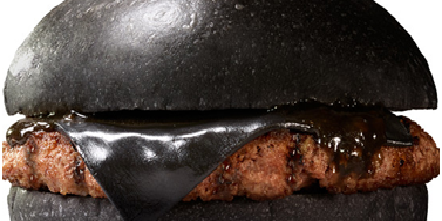originally appeared in The Week dated OCTOBER 5, 2014
Burger King recently announced that they will be selling the Kuro Pearl burger and Kuro Diamond burger beginning on Sept. 19 in Japan. These burgers come with black bun, black sauce and black cheese in addition to black-pepper heavy beef patties (Kuro means black in Japanese). Even previously, in 2012 and 2013, these burgers have been made available as a limited edition item, only in Japan.
So why does a “black” burger make a comeback year after year only in a specific country? Why is it sold as a limited edition item? What makes the Japanese take up this dish, which most of us would find unbelievable even conceptually? How strong an impact can a mere colour have on our psychology and perceived impressions?
As far as foods go, Japanese have long been including “black” food in their diet, right from black soybean, to black vinegar drinks, black rice, black mushrooms, and the like. For most of the other cultures, a “black” ingredient may be added here and there, like black pepper, black salt, or the squid ink, also used in the Kuro Burger. But the colour black has usually been associated with decaying or fungus infected food and the very idea of eating an entirely black burger sounds a bit repulsive.
Experimenting with weird colours has not been new in the food industry, or for Burger King itself. In 2000, Heinz had experimented with their Green Sauce, dubbed as the ET Squirt. During the next three years they introduced three more variations of this radically different looking ketchup. The line of product got discontinued in 2006. In 2012, Burger King teamed up with Heinz to reintroduce the “green ketchup” concept, this time as part of a St. Patrick’s Day promotion in which free fries were given away with packets of the green sauce.
So what is the significance of colours, particularly black? Colour cues transmit important non verbal information about emotions, feelings and moods, says David Givens in the Non verbal dictionary. He says the colour black is usually associated with moods like sadness, intensity, anxiety, fear. Symbolically, black stands for darkness, power, decay, mystery, wisdom, death, atonement and protection.
The play of color black is used by all of us in our daily lives. Take the instance of clothing. A lady might choose to wear a black evening gown on her date if she wants to look suave and sexy, or even mysterious. A black tie event calls for all those invited to come dressed formally, reflecting sophistication. A lot of us choose to wear black when unsure what color to wear for a particular event. Heavyweight people claim wearing black makes it easier to hide their bulk. Black is also the colour taken up by a widow in mourning.
Commercially, black has very different associations in different contexts. While black food might seem indigestible, black sedans seem posh and elegant. Carefully used black adds drama to any room décor, explains Kshipra Bhardwaj, Mumbai based interior designer. It also helps create an illusion of depth in an otherwise shallow space.
Even after the world welcomed color camera rolls, photographers have been purposefully using the concept of blackening out all colors from a photograph and making it black and white. For me, the shot looks visually more stimulating, says Vinit Bhatt, fashion photographer. I love the way bright colors don’t take away focus from the central character or item, simply by making the colors vanish from the screen, he smiles and adds.
The movie industry exploits the color black to add to a character’s personality. In the stereotypical role, the good guy is shown to be in white and the villain in black. In more recent times, however the good guy is shown in black to create mystery around the character’s identity. Chirstopher Nolan brought us closer to Batman with his famous movie on the same superhero. Batman is seen lurking in the dark, adopting his deepest fear, the bat as his insignia. Batman, always pictured in dark alleys wearing a black cape and black hood, is projected to be a common man wanting to become the fear in the hearts of the villains attacking the city of Gotham.
The influence of color on consumer products has been so firmly established that there are color consultants pursuing a full time career in advising field experts, right from interior designers to brand managers and advertising agencies.
All said, the very idea of a black burger seems highly experimental. Kudos to Burger King for wanting to try out the unconventional and to the Japanese for not rooting to food stereotypes, as most of the other cultures do. Whether to deviate from established perceptions is a call that every company takes for itself. It is a risky call, since it can add to confusion in the minds of the customers.
This lock down period, get exciting offers on our webinars to know more visit link here
HOW WE CAN HELP
Enhance your teaching impact with our tailored programs focused on improving non-verbal communication. Learn to build stronger connections with students, manage classrooms effectively, and boost student engagement. If you are looking to upgrade your body language skills, check out our online pre recorded courses on various topics that come with lifetime access. You can also explore our Signature Body Language Personal Coaching program Reach out to us on – 99309 41534.























